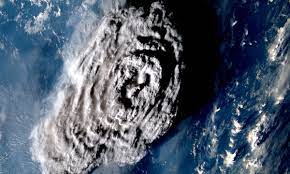A huge underwater volcanic event in Tonga last year was of a magnitude comparable with the most powerful nuclear detonation by the U.S, researchers have revealed.
Scientists have used eye and earwitnesses accounts, along with data from tide gauges, satellites, evidence of broken windows and other sources, to calculate that the eruption of the Hunga Tonga-Hunga Ha’apai volcano, which occurred on 15 January 2022 and was felt around the world, likely involved five blasts. The last of them released energy equivalent to about 15 megatonnes of TNT.
That is around 1,000 times more powerful than the bomb that was dropped on Hiroshima in 1945, and puts the volcanic event on a par with the most powerful nuclear device ever detonated by the US: the Castle Bravo bomb detonated at Bikini Atoll in 1954.
The team, based at institutions in the U.S and New Zealand, added that the volcanic event, which occurred 65km (40 miles) from the country’s main island, involved both eruptions – which resulted in huge volcanic plumes being thrust into the stratosphere – and explosions of steam, which caused sonic booms and were the main cause of the related tsunami.
The researchers’ computer simulations of the event, based on a combination of data sources, suggest the western coast of Tofua Island experienced waves of up to 45 metres in height, a result they say is backed up by signs of vegetation scars at the same altitude captured by satellite and drone data.
The eruption brought reports of people experiencing the ground and buildings shaking for hours as far away as Fiji – nearly 500 miles away.
It is thought that six people died as a result of the Hunga Tonga-Hunga Ha’apai volcanic event, including four people in Tonga and two in Peru who drowned as a result of abnormally large waves caused by the volcanic activity.
The team say the huge waves in parts of Tonga would have been expected to result in a larger death toll – yet this was not the case.
“The main factors that led to this, we suggest, are the quirk of the location, a worldwide pandemic, and increased evaluation drills and awareness efforts carried out in the years’ prior,” they write in the journal Science Advances.
Tofua is uninhabited and other areas that experienced large waves were sparsely populated, while tourist resorts were closed because of Covid.
“The main settlements in all of Tonga safely face Nuku’alofa Lagoon, the best possible scenario to duck the full brunt of a mega-tsunami,” the authors note, adding that other inhabited islands sit atop a carbonate platform where shallow waters damped down the waves.
The new study follows research published last year that revealed that the Tonga volcano eruption had the highest plume ever recorded, with an ash cloud that reached 57km (35 miles) in height.
Dr Mohammad Heidarzadeh of the University of Bath, who was not involved in the new study but has also carried out research into the event, said the latest work offered the most detailed modelling of the Tonga tsunami so far by benefiting from a diverse observation dataset.
“Modelling tsunamis from volcano eruptions is a challenging task and this has been nicely done by [the team],” he said. “It is interesting that the results are consistent with our previous study on this event, where we reported a maximum tsunami wave height of 90m, said Dr Heidarzadeh.
SOURCE: THE GUARDIAN/PACNEWS














